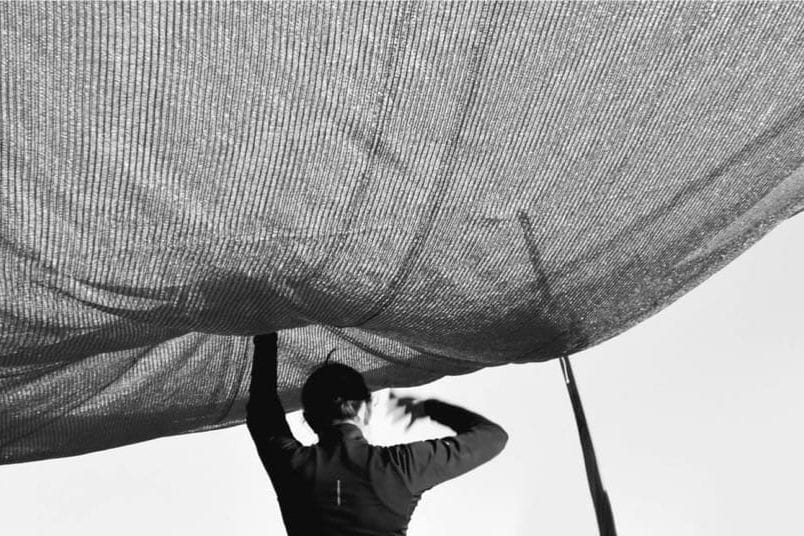For several years now, the undeniable and almost parallel relationship between image-making and archaeology has been acknowledged. While photography was initially a means of capturing archaeological monuments rather than the excavation process itself, it has now become an integral part of the excavational toolkit.
In fact, the production of images –such as maps, photographs, diagrams, stratigraphies, and representations– is a fundamental element in constructing an archaeological process.
However, there is a significant debate about how “objective” or “interpretive” these depictions are or should be. In an academic archaeological photograph, where the goal is a “clean” and timeless imprint of an archaeological trench, for instance, it’s challenging for the subject of the research –the perspective of the scholar– to intrude into the Cartesian logic of the photographic frame.
The connection between creative photography and contemporary art with archaeology –and antiquity in general– is not a new field of experimentation. However, in recent years, there has been a strong need for different ways of narrating within archaeological discourse, where visualization becomes a significant methodological tool. Moreover, the close relationship between archaeology and anthropology equally influences the use of visual/auditory media –static and moving images– in the interpretation of antiquity.
A particular field where visualization is fundamental is archaeological ethnography. Its goal is to recognize that the study of the past is not limited to archaeological classifications of material remains but also involves their production and consumption in the contemporary social context. This is most emphasized, when we recognize that an archaeological site constitutes a multi-temporal stage, with many different spectators and actors, the visualization of which can highlight various aspects of the archaeological process –and consequently reveal many associations and meanings.
Drawing from experience gained from previous experimental projects of visualizing both the archaeological practice and antiquity in general (such as the excavations at Neolithic Dispilio in Kastoria and the Sanctuary of Poseidon in Kalaureia on the Island of Poros, as well as the Athenian Acropolis), the Koutroulou Magoula program also encompasses archaeological photo-ethnography.
The aim is to create a parallel archive of captures of the excavation praxis, which does not merely supplement archaeological discourse with imagery, but will itself consist the raw material for generating new, experimental, narratives.
Εδώ και αρκετά χρόνια έχει αναγνωρισθεί η αδιάρρηκτη και σχεδόν παράλληλη πορεία και σχέση της εικόνας με την αρχαιολογία. Αν και η φωτογραφία αρχικά ήταν το μέσο απαθανάτισης αρχαιολογικών μνημείων και όχι της ίδιας της ανασκαφικής πράξης, πλέον αποτελεί ένα αυτονόητο τμήμα της ανασκαφικής εργαλειοθήκης.
Στην πραγματικότητα η παραγωγή εικόνων –όπως χάρτες, φωτογραφίες, διαγράμματα, στρωματογραφίες, αναπαραστάσεις– αποτελεί ένα από τα βασικά στοιχεία στην κατασκευή μιας αρχαιολογικής διαδικασίας.
Ωστόσο, υπάρχει πολύ μεγάλη συζήτηση για το πόσο «αντικειμενικές» ή «ερμηνευτικές» είναι ή δικαιούνται να είναι αυτές οι απεικονίσεις. Σε μια ακαδημαϊκή αρχαιολογική φωτογραφία, όπου ο στόχος είναι η «καθαρή» και αχρονική αποτύπωση ενός αρχαιολογικού σκάμματος, για παράδειγμα, δύσκολα μπορεί να παρεισφρήσει στο καρτεσιανής λογικής φωτογραφικό κάδρο το ίδιο το υποκείμενο της έρευνας, το βλέμμα του μελετητή.
Η ζεύξη της δημιουργικής φωτογραφίας και της σύγχρονης τέχνης με την αρχαιολογία –και την αρχαιότητα γενικά– ασφαλώς δεν είναι ένα καινούργιο πεδίο πειραματισμού. Τα τελευταία χρόνια, όμως, είναι έντονη η ανάγκη διαφορετικών τρόπων αφήγησης στον αρχαιολογικό λόγο, όπου η εικονοποίηση αποτελεί σημαντικό μεθοδολογικό εργαλείο. Επιπλέον, η στενή σχέση της αρχαιολογίας με την ανθρωπολογία εξίσου επηρεάζει και τη χρήση των οπτικοακουστικών μέσων –της στατικής και κινούμενης εικόνας– στην ανάγνωση της αρχαιότητας.
Ένα ιδιαίτερο πεδίο, όπου η εικονοποίηση είναι θεμελιώδης, είναι η αρχαιολογική εθνογραφία. Στόχος της είναι η αναγνώριση ότι η μελέτη του παρελθόντος δεν περιορίζεται στις αρχαιολογικές ταξινομήσεις των υλικών καταλοίπων αλλά αφορά και την παραγωγή και κατανάλωσή του στο σύγχρονο κοινωνικό πλαίσιο. Ιδιαίτερα, όταν αναγνωρίσουμε ότι ένας αρχαιολογικός τόπος αποτελεί ένα πολυχρονικό σκηνικό, στο οποίο υπάρχουν πολλοί και διαφορετικοί θεατές και ηθοποιοί, η εικονοποίηση των οποίων μπορεί να αναδείξει πολλές και διαφορετικές πτυχές της αρχαιολογικής πράξης και να ανασύρει και να αφηγηθεί, κατά συνέπεια, συνειρμούς και νοήματα.
Έχοντας εμπειρία που προήλθε από προηγούμενες πειραματικές εργασίες εικονοποίησης τόσο της αρχαιολογικής πράξης όσο και γενικότερα της αρχαιότητας (τις ανασκαφές στο νεολιθικό Δισπηλιό Καστοριάς και στο Ιερό του Ποσειδώνα στην Καλαυρεία του Πόρου, καθώς και την αθηναϊκή Ακρόπολη), στο πρόγραμμα της Κουτρουλού Μαγούλας εντάσσεται και η αρχαιολογική φωτο-εθνογραφία.
Στόχος είναι η δημιουργία ενός παράλληλου αρχείου καταγραφής των στιγμών της ανασκαφικής πράξης, το οποίο δεν εικονογραφεί συμπληρωματικά τον αρχαιολογικό λόγο αλλά θα αποτελεί το ίδιο την πρώτη ύλη για τη δημιουργία νέων, πειραματικών, αφηγήσεων.
See also | Βλ. επίσης
Hamilakis, Y. 2011. Archaeological ethnography: A multitemporal meeting ground for archaeology and anthropology. Annual Review of Anthropology 40, 399–414. https://doi.org/10.1146/annurev-anthro-081309-145732
Hamilakis, Y. & Anagnostopoulos, Α. (eds. | επιμ.) 2009. Archaeological Ethnographies. Leeds/London: Manney [Public Archaeology 8 (2/3)].
Hamilakis, Y., Anagnostopoulos, A. & Ifantidis, F. 2009. Postcards from the edge of time: Archaeology, photography, archaeological ethnography (a photo-essay). Public Archaeology 8(2/3), 283–309. https://doi.org/10.1179/175355309X457295
Hamilakis, Y. & Ifantidis, F. 2016. The other Acropolises: Multi-temporality and the persistence of the past. In | Στο The Oxford Handbook on the Archaeology of the Contemporary World (eds. | επιμ. P. Graves-Brown, R. Harrison & A. Piccini), 758–81. Oxford: Oxford University Press. https://doi.org/10.1093/oxfordhb/9780199602001.013.032
Hamilakis, Y. & Ifantidis, F. 2013. Camera Kalaureia: An Archaeological Photo-Ethnography | Μια Αρχαιολογική Φωτο-Εθνογραφία. Oxford: Archaeopress.
Hamilakis, Y. & Ifantidis, F. 2015. The photographic and the archaeological. The ‘other acropolis’. In | Στο Camera Graeca: Photographs, Narratives, Materialities (eds. | επιμ. P. Carabott, Y. Hamilakis & E. Papargyriou), 133–57. Oxford: Routledge.
Ifantidis, F. 2013. Archaeographies: Excavating Neolithic Dispilio. Oxford: Archaeopress.
Ifantidis, F. 2015. A figurine and its scale, a scale and its figurine. Internet Archaeology 39. https://doi.org/10.11141/ia.39.10







